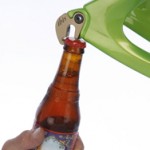the HRM trained group showed significantly greater increases in peak output (5.0% vs 3.5%)
Don’t get me wrong, I’d love to have a power meter. I just can’t justify spending $1500 or more on one. I’ve read that some very experienced riders would take an old bike with a power meter over a new bike without one, but I’m not convinced. I found this article from March, 2009 that supports that view, “Put Down That Power Meter, Eugene“.
If this is repeatable, I think there may be two reasons why the HRM group did better than the power meter group, one related to recovery, the other related to adaptation. My guess is that when a rider is not well recovered, a heart rate based target will account somewhat for that. In other words, a power-based target remains the same no matter how tired an athlete is, while one’s heart rate is likely to be affected by fatigue and naturally ratchet the effort level to lower power. I know that training at consistent power is something proponents of power meters site as an advantage, but it could be an obstacle to good recovery.
The second reason, and probably the more important of the two: Hopefully as one adapts to training, the power that can be maintained at a given heart rate increases. By training with a heart rate target, the power level will naturally adjust upward. If training with power, as one improves, the power target would remain the same, while the heart rate decreases. My intuition is that by training with an HRM one’s power level is always incrementally adjusting, whereas a power target would often not be adjusted for as long as 2-4 weeks, until the next test.
For those reasons, even before I saw this study, I questioned the supremacy of power meters for endurance training. Though I’d guess that power meters are far better for anaerobic training; when the rider is doing short, hard sprints where heart rate response lags behind effort. It’s unlikely that sprint training was even included in this study, since HRM’s give such poor feedback in that situation.
Ideally one would use both power and heart rate data, but this study indicates that at least for some aspects of cycling training, a heart rate monitor can be as good or better than a power meter.

